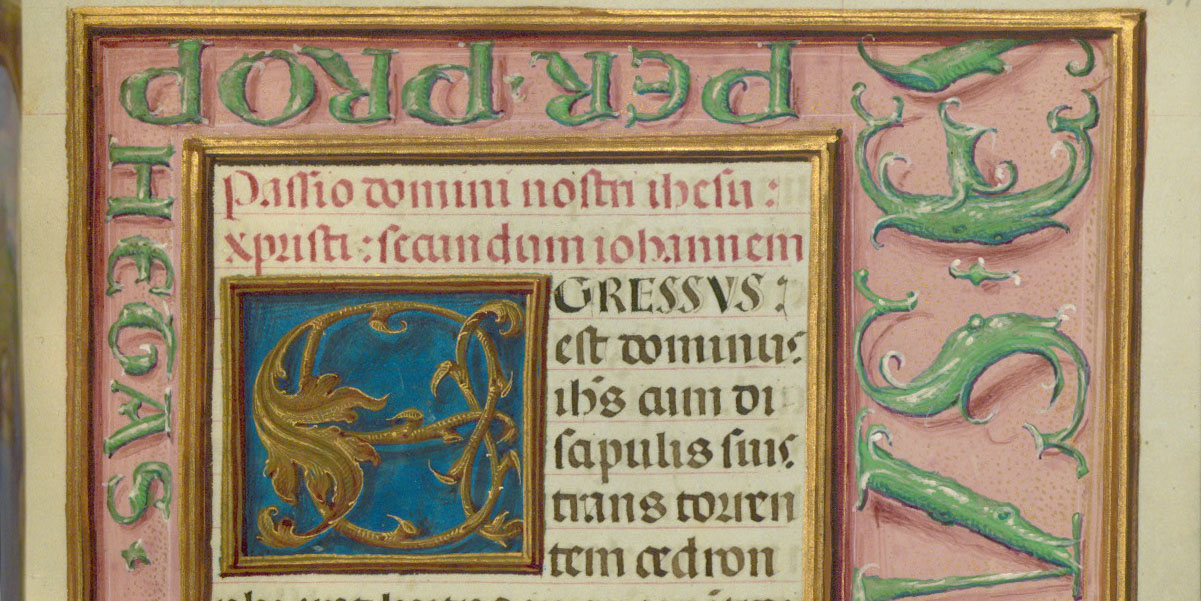How the heck did it get to be the fourth week of the semester already? We are rolling under a full head of steam in this semester’s manuscript course; the students are deep into the structure of Books of Hours and just now working with medieval paleography. We’re back studying the Hargrett Hours in the second half of the fall, with an ambitious project for the semester.
First, a recap of what’s our student have discovered about the Hargrett Hours over the past two years.
In Fall 2016, the inaugural class figured out that the Hargrett Hours is from Paris, and its calendar is specifically Use of Sainte-Chapelle, the royal chapel attached to Notre Dame Cathedral. Its contents are equally distinctive: it contains no Hours of the Virgin, at least in its current state, but it does have the Long Hours of the Passion; the Passion narrative from the Gospel of John; a cluster of six Passion-related prayers (one in French!); and an array of suffrages, with special emphasis on the apostles and members of Mary’s family. The manuscript has been through hard times; it’s fragmentary, especially at the end, and it’s now on its third binding (at least).
In 2017-2018, two of the Fall 2016 students kept working on the Passion texts at the core of the Hargrett Hours. Madison discovered that there is a method to the madness of the Long Hours of the Passion, as they appear across Books of Hours, and that the version in the Hargrett Hours aligns with the most common set of hymns and psalms for the Long Hours. Katie continued to hunt down instances of the Latin Passion prayers, and determined that three of them tend to circulate together, and that (as far as we can tell so far) one is unique.
The Fall 2018 iteration of the course — aka HH2.0, Now With More Passion! — is building on Katie and Madison’s discoveries, with a digital twist. We’re going to extend our research on medieval (especially but not only French) devotion to the Passion, so that we can better contextualize the Passion materials within the Hargrett Hours. We’ll be asking questions not only of these texts’ frequency, but also of the kind of devotional engagement they encourage. What might it mean to contemplate the Passion via the John passage, as opposed to using one of the imaginative recreations of the Passion, such as the psuedo-Bonaventurian Meditations on the Life of Christ? Margery Kempe is famously extra in her devotion to Christ — how do these spiritual exercises jive (or not) with her experiences? What other kinds of Passion prayers were laypeople consuming, and do their emphases align with these prayers? How might Passion meditation without images — as we have in the Hargrett Hours — operate differently than such meditation with images of the Crucifixion or the Five Wounds? Did Passion devotion in northern France differ in any meaningful way from the examples we have from England or the Low Countries? (And are these even the right questions to ask?)
All this research into Passion devotion is going to pay dividends for you, dear reader! With the help of the great people at UGA’s DigiLab and the digitization efforts spearheaded by the Special Collections Library staff, we are going to pilot an early version of the Hargrett Hours digital edition. We’ll have a sister website to this blog, hosted by the DigiLab, on which we’ll reproduce the pages from the Hargrett Hours with the auxiliary prayers, provide a clean edition of those prayers, and supplement the prayers with interpretive information on their frequency in Books of Hours and their place in the broader landscape of late medieval Passion devotion. It’s only a few pages from the Hargrett Hours, but it’s a big project to conceptualize the larger structure that the final edition will have.
So watch this space for further updates on our research into Passion devotion, Books of Hours, and creating a digital edition from scratch.
Image: Walters Library MS w.441, fol. 79r, the opening to the Passion account from the Gospel of John.
